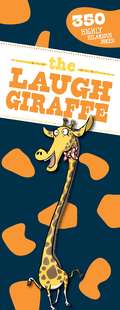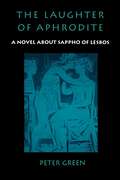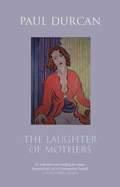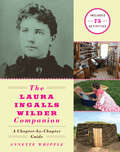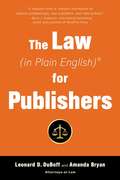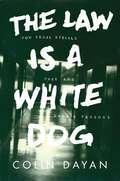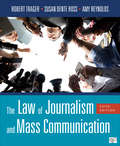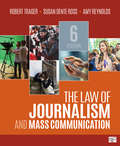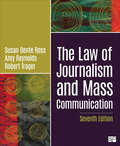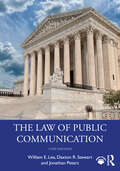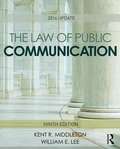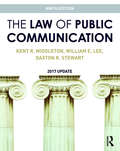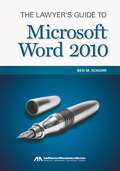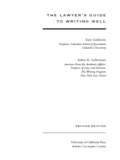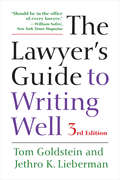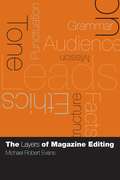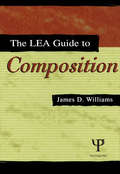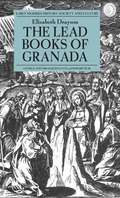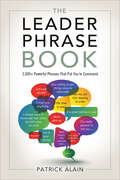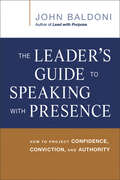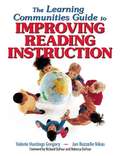- Table View
- List View
The Laugh Giraffe: 350 Hilarious Jokes!
by Sky Pony PressWhat is it that even the most careful person overlooks? His nose!What do you call a dinosaur with a big vocabulary? A thesaurus! A hilarious collection of 350 unique jokes presented by the highly hilarious Laugh Giraffe for kids to enjoy, complete with hysterical illustrations!Do you ever struggle to find new jokes? Never fear! Using his long neck to search high and low, far and wide, the Laugh Giraffe can find all the best jokes for you! Prepare for witty one-liners, clever puns, powerful punchlines, jubilant jests, and many more hilarious jokes in this fantastic collection. The Laugh Giraffe is filled to the brim with both classic and original jokes to make readers keel over in laughter. Written to meet the unquenchable needs of the millions of children eternally hungry for joke books, this collection is complete with 350 hilarious jokes and is complemented by silly line drawings that are sure to amuse kids. Its endless supply of fresh content and splashy, engaging design—right down to the tall and narrow shape of the book itself—make The Laugh Giraffe a sure source of fun for young readers as well as parents, siblings, and friends! Perfect for long car rides and rainy days, this book is certain to bring laughter and fun to little ones and the whole family.
The Laughter of Aphrodite: A Novel about Sappho of Lesbos
by Peter GreenBest-selling classicist Peter Green recreates the life and times of the Greek lyric poet Sappho in this beautifully conceived, sharply detailed work of historical imagination. We meet Sappho at the age of fifty, when she is shaken by her fatal and final love affair with Phaon. She narrates her own story from the vantage point of self-questioning middle age, and her candid meditations make intimate, engrossing reading.Only fragments of Sappho's poetry survive. In imagining Sappho's life Green found his task "rather like that of an archaeologist reassembling some amphora from hundreds of shards—of which more than half are missing." Yet, in his synthesis of historical evidence and ebullient invention, Green produces a seamless, moving, and persuasive portrait. He recreates Sappho's life by interweaving her surviving poetry into the narrative, not as quotations, but as her own imagined speeches and thoughts.Sappho's life spanned one of the most exciting periods in Greek history. Green's novel, full of details about daily life on ancient Lesbos, draws the reader into the political and social climate of her world: the civil strife accompanying the transition from aristocracy to mercantilism, the household relations between slave and aristocrat, the details of sea travel in the Aegean. Green wrote the novel while living on Lesbos, and his graceful rendering of the landscape, the rhythms of the seasons, and the varied flora of Sappho's island pervades the narrative.Sappho's poetry reveals a direct, spontaneous woman who eschewed artifice and embellishment. Green's extraordinary talent captures those qualities and brings this woman of unflinching honesty very much to life.
The Laughter of Mothers
by Paul Durcan'Thank you, O golden mother, / For giving me a life,' says Paul Durcan in this brilliant new collection, a poignant tribute to 'the first woman I ever knew'. Sheila MacBride came from a political family – her uncle John MacBride was executed in 1916 for his part in the Easter Uprising – but when Sheila married into the 'black, red-roaring, fighting Durcans of Mayo' she was obliged to give up a promising legal career. These poems commemorate his mother as Paul Durcan remembers her playing golf, reading Tolstoy, and initiating him in the magic of the cinema. He recalls her compassion and loyalty when he was committed to a mental hospital in adolescence and how she endured the ordeal of her old age.Durcan also muses upon the beauty of Greek women and questions our need for newspapers and the new religion of golf. He is beguiled by a beggar woman, enraged by a young man picking his nose on the Dublin–Sligo commuter train, and gets into difficulty at the security gate of Dublin airport.
The Laura Ingalls Wilder Companion: A Chapter-by-Chapter Guide
by Annette WhippleThe Laura Ingalls Wilder Companion helps eager readers experience and discover Wilder's books like never before. Author Annette Whipple encourages children to engage in pioneer activities while thinking deeper about the stories and real-life circumstances of the Ingalls and Wilder families as portrayed in the nine Little House books. This valuable companion provides brief introductions to each Little House book, chapter-by-chapter story guides, and additional information related to each of the books' content and history. "Fact or Fiction" sidebars tell the surprising truth about Laura Ingalls Wilder's writing, while 75 activities, crafts, and recipes encourage kids to "Live Like Laura" using easy-to-find supplies. Thoughtful questions help the reader develop appreciation and understanding for stories. Every aspiring adventurer will enjoy this walk alongside Laura from the big woods to the golden years.
The Law (In Plain English #1)
by Leonard D. Duboff Amanda Bryan“A treasure trove of relevant information for industry professionals, new publishers, and indie authors.” —Kevin J. Anderson, #1 international bestselling author and publisher of WordFire Press In The Law (in Plain English)® for Publishers, Leonard DuBoff and Amanda Bryan tackle the many legal considerations of the publishing world. Both new and seasoned publishers and industry professionals will find the information they need as the authors break down the intricacies of the business in thorough yet concise explanations. Chapters cover important topics such as: Privacy, defamation, and other content issues Copyright basics, protection, and infringement Negotiating with authors and literary agents Contract terms Books in the digital age Publishing as a business Tax considerations An indispensable reference, The Law (in Plain English)® for Publishers belongs on the shelves of all publishers, industry professionals, and enterprising authors.
The Law Is a White Dog: How Legal Rituals Make and Unmake Persons
by Colin DayanA fascinating account of how the law determines or dismantles identity and personhoodAbused dogs, prisoners tortured in Guantánamo and supermax facilities, or slaves killed by the state—all are deprived of personhood through legal acts. Such deprivations have recurred throughout history, and the law sustains these terrors and banishments even as it upholds the civil order. Examining such troubling cases, The Law Is a White Dog tackles key societal questions: How does the law construct our identities? How do its rules and sanctions make or unmake persons? And how do the supposedly rational claims of the law define marginal entities, both natural and supernatural, including ghosts, dogs, slaves, terrorist suspects, and felons? Reading the language, allusions, and symbols of legal discourse, and bridging distinctions between the human and nonhuman, Colin Dayan looks at how the law disfigures individuals and animals, and how slavery, punishment, and torture create unforeseen effects in our daily lives.Moving seamlessly across genres and disciplines, Dayan considers legal practices and spiritual beliefs from medieval England, the North American colonies, and the Caribbean that have survived in our legal discourse, and she explores the civil deaths of felons and slaves through lawful repression. Tracing the legacy of slavery in the United States in the structures of the contemporary American prison system and in the administrative detention of ghostly supermax facilities, she also demonstrates how contemporary jurisprudence regarding cruel and unusual punishment prepared the way for abuses in Abu Ghraib and Guantánamo.Using conventional historical and legal sources to answer unconventional questions, The Law Is a White Dog illuminates stark truths about civil society's ability to marginalize, exclude, and dehumanize.
The Law of Journalism and Mass Communication
by Amy L. Reynolds Robert E. Trager Susan D. RossThe Law of Journalism and Mass Communication is the media law text your students will want to read. Esteemed authors Robert Trager, Susan Dente Ross and Amy Reynolds tailor this text to the needs of future journalists and media professionals. They provide a current and comprehensive survey of media law and its effects on mass communication complete with real-world, landmark court rulings in context, scenarios from significant cases, cutting-edge research, photographs and feature boxes that offer snapshots of media law in practice to spark classroom discussion and encourage critical thinking. This thoroughly revised Fifth Edition includes a sharp focus on how the law applies to newsgathering and dissemination in the digital age. It offers new social media law boxes, new case excerpts and new features to keep students abreast of the latest developments in the law and its application.
The Law of Journalism and Mass Communication
by Amy L. Reynolds Robert E. Trager Susan D. RossThe Law of Journalism and Mass Communication, Sixth Edition, by Robert Trager, Susan Dente Ross, and Amy Reynolds offers a clear and engaging introduction to media law with comprehensive coverage and analysis of key cases for future journalists and media professionals. You are introduced to key legal issues at the start of each chapter, building your critical thinking skills before progressing to real-world landmark cases that demonstrate how media law is applied today. Contemporary examples, emerging legal topics, international issues, and cutting-edge research all help you to retain and apply principles of media law in practice. The thoroughly revised Sixth Edition has been reorganized and shortened to 12 chapters, streamlining the content and offering instructors more opportunities for classroom activities. This edition also goes beyond the judiciary—including discussions of tweets and public protests, alcohol ads in university newspapers, global data privacy and cybersecurity, libel on the internet, and free speech on college campuses—to show how the law affects the ways mass communication works and how people perceive and receive that work.
The Law of Journalism and Mass Communication
by Amy L. Reynolds Robert E. Trager Susan D. RossThe Law of Journalism and Mass Communication, Sixth Edition, by Robert Trager, Susan Dente Ross, and Amy Reynolds offers a clear and engaging introduction to media law with comprehensive coverage and analysis of key cases for future journalists and media professionals. You are introduced to key legal issues at the start of each chapter, building your critical thinking skills before progressing to real-world landmark cases that demonstrate how media law is applied today. Contemporary examples, emerging legal topics, international issues, and cutting-edge research all help you to retain and apply principles of media law in practice. The thoroughly revised Sixth Edition has been reorganized and shortened to 12 chapters, streamlining the content and offering instructors more opportunities for classroom activities. This edition also goes beyond the judiciary—including discussions of tweets and public protests, alcohol ads in university newspapers, global data privacy and cybersecurity, libel on the internet, and free speech on college campuses—to show how the law affects the ways mass communication works and how people perceive and receive that work.
The Law of Journalism and Mass Communication
by Amy L. Reynolds Robert E. Trager Susan D. RossIn The Law of Journalism and Mass Communication, authors Susan Dente Ross, Amy Reynolds, and Robert Trager present a lively, up-to-date, and comprehensive introduction to media law that brings the law to life for future professional communicators. The book is grounded in the traditions and rules of law but also contains fresh facts and relevant examples that keep readers engaged. Tightly focused breakout boxes highlight contemporary examples of the law in action or emphasize central points of law as well as intersections with international law and policy. The thoroughly updated Seventh Edition contains a wealth of new content that is as timely as possible—from the U.S. Supreme Court, federal and state courts, Congress, executive agencies, federal and state policymakers and advisory groups, and media organizations and allies. A refreshed look, feel, and flow of chapters provide readers an understanding of fast-expanding areas of the law and legal complexities.
The Law of Journalism and Mass Communication
by Amy L. Reynolds Robert E. Trager Susan D. RossIn The Law of Journalism and Mass Communication, authors Susan Dente Ross, Amy Reynolds, and Robert Trager present a lively, up-to-date, and comprehensive introduction to media law that brings the law to life for future professional communicators. The book is grounded in the traditions and rules of law but also contains fresh facts and relevant examples that keep readers engaged. Tightly focused breakout boxes highlight contemporary examples of the law in action or emphasize central points of law as well as intersections with international law and policy. The thoroughly updated Seventh Edition contains a wealth of new content that is as timely as possible—from the U.S. Supreme Court, federal and state courts, Congress, executive agencies, federal and state policymakers and advisory groups, and media organizations and allies. A refreshed look, feel, and flow of chapters provide readers an understanding of fast-expanding areas of the law and legal complexities.
The Law of Public Communication
by William E. Lee Kent R. Middleton Daxton R. StewartNow in its tenth edition, The Law of Public Communication provides an overview of media law that includes the most current legal developments. It explains the laws affecting the daily work of writers, broadcasters, PR practitioners, photographers, and other public communicators. By providing statutes and cases in an accessible manner, even to students studying law for the first time, the authors ensure that students will acquire a firm grasp of the legal issues affecting the media. This new edition features color photos, as well as breakout boxes that apply the book’s principles to daily life. The new case studies discussed often reflect new technologies and professional practices.
The Law of Public Communication
by William E. Lee Daxton R. Stewart Jonathan PetersThis thoroughly updated classic textbook provides an overview of communication and media law, including the most current legal developments. It explains laws affecting the daily work of writers, broadcasters, public relations practitioners, photographers, bloggers and other public communicators.By outlining statutes and cases in an accessible manner, even to students studying law for the first time, the authors ensure that readers acquire a firm grasp of the legal issues affecting the media. The book examines legal topics such as libel, privacy, intellectual property, obscenity and access to information, considering the development and current standing of relevant laws and important cases. It examines how these laws affect public, political and commercial communication. The 13th edition covers contemporary U.S. Supreme Court cases, including the true threats case Counterman v. Colorado, the Andy Warhol fair use case and the Jack Daniel's trademark parody case. It also presents the Biden administration's revision of policy on the use of subpoenas and search warrants to uncover reporters' confidential sources along with the gag orders imposed by courts handling criminal and civil trials in which Donald Trump is a defendant. Further cases explored include the attacks by legislatures against the LGBTQ community, exemplified by a Tennessee law banning drag performances, and the emerging issues presented by artificial intelligence and the content moderation policies of social media platforms.The Law of Public Communication is an ideal core textbook for undergraduate and graduate courses in communication law and mass media law.A test bank for instructors is available at www.routledge.com/9781032676388
The Law of Public Communication: 2016 Update
by William E. Lee Daxton Stewart Kent R. MiddletonThe Law of Public Communication provides an overview of media law that includes the most current legal developments today. It explains the laws affecting the daily work of writers, broadcasters, advertisers, cable operators, Internet service providers, public relations practitioners, photographers, bloggers, and other public communicators. Authors Kent R. Middleton, William E. Lee, and Daxton R. Stewart take students through the basic legal principles and methods of analysis that allow students to study and keep abreast of the rapidly changing field of public communication. By providing statutes and cases in a cohesive manner that is understandable, even to students studying law for the first time, the authors ensure that students will acquire a firm grasp of the legal issues affecting the media. This 2017 Update brings the Ninth Edition up to date with the most recent cases and examples affecting media professionals and public communicators.
The Law of Public Communication: 2017 Update
by William E. Lee Daxton Stewart Kent R. MiddletonThe Law of Public Communication provides an overview of media law that includes the most current legal developments today. It explains the laws affecting the daily work of writers, broadcasters, advertisers, cable operators, Internet service providers, public relations practitioners, photographers, bloggers, and other public communicators. Authors Kent R. Middleton, William E. Lee, and Daxton R. Stewart take students through the basic legal principles and methods of analysis that allow students to study and keep abreast of the rapidly changing field of public communication. By providing statutes and cases in a cohesive manner that is understandable, even to students studying law for the first time, the authors ensure that students will acquire a firm grasp of the legal issues affecting the media. This 2017 Update brings the Ninth Edition up to date with the most recent cases and examples affecting media professionals and public communicators.
The Lawyer's Essential Guide to Writing: Proven Tools and Techniques
by Marie BuckleyThe Lawyer's Essential Guide to Writing is a readable, concrete guide to contemporary legal writing. Based on Marie Buckley's years of experience coaching lawyers, this book provides a systematic approach to all forms of written communication, from memoranda and briefs to e-mail and blogs. The book sets forth three principles for powerful writing and shows how to apply those principles to develop a clean and confident style.
The Lawyer's Guide to Microsoft® Word 2010
by Ben M. SchorrThis handy reference includes clear explanations, legal-specific descriptions, and time-saving tips for getting the most out of Microsoft Word®--and customizing it for the needs of today's legal professional. Focusing on the tools and features that are essential for lawyers in their everyday practice, The Lawyer's Guide to Microsoft® Word 2010 explains in detail the key components to help make you more effective, more efficient, and more successful.
The Lawyer's Guide to Writing Well
by Tom Goldstein Jethro K. LiebermanThis eminently practical volume demystifies legal writing, outlines the causes and consequences of bad writing, and prescribes straightforward, easy-to-apply remedies that will make your writing readable. Complete with usage notes that address lawyers' most common errors, this well-organized book is both an invaluable tool for practicing lawyers and a sensible grounding for law students. This much-revised second edition contains a set of editing exercises (and a suggested revision key with explanations) to test your skill. This book is a definitive guide to becoming a better writer--and a better lawyer.
The Lawyer's Guide to Writing Well
by Tom Goldstein Jethro K. LiebermanThis eminently practical volume demystifies legal writing, outlines the causes and consequences of bad writing, and prescribes straightforward, easy-to-apply remedies that will make your writing readable. Complete with usage notes that address lawyers' most common errors, this well-organized book is both an invaluable tool for practicing lawyers and a sensible grounding for law students. This much-revised second edition contains a set of editing exercises (and a suggested revision key with explanations) to test your skill. This book is a definitive guide to becoming a better writer--and a better lawyer.
The Layers of Magazine Editing
by Michael Robert EvansUnlike the myriad writing manuals that emphasize grammar, sentence structure, and other skills necessary for entry-level editing jobs, this engaging book adopts a broader view, beginning with the larger topics of audience, mission, and tone, and working its way down, layer by layer, to the smaller questions of grammar and punctuation. Based on Michael Evans's years of experience as an editor and supplemented by invaluable observations from the editors of more than sixty magazines—including The Atlantic, Better Homes and Gardens, Ebony, Esquire, and National Geographic—this book reveals the people-oriented nature of the job.
The Lea Guide To Composition
by James D. WilliamsBasic text for freshman composition courses. Draws on the most significant theory, strategy, and techniques in composition studies. Emphasizes writing as a vehicle for learning.
The Lead Books of Granada
by Elizabeth DraysonHailed as early Christian texts as important as the Dead Sea Scrolls, yet condemned by the Vatican as Islamic heresies, the Lead books of Granada, written on discs of lead and unearthed on a Granadan hillside, weave a mysterious tale of duplicity and daring set in the religious crucible of sixteenth-century Spain. This book evaluates the cultural status and importance of these polyvalent, ambiguous artefacts which embody many of the dualities and paradoxes inherent in the racial and religious dilemmas of Early Modern Spain. Using the words of key individuals, and set against the background of conflict between Spanish Christians and Moriscos in the late fifteen-hundreds, The Lead Books of Granada tells a story of resilient resistance and creative ingenuity in the face of impossibly powerful negative forces, a resistance embodied by a small group of courageous, idealistic men who lived a double life in Granada just before the expulsion of the Moriscos.
The Leader Phrase Book: 3,000+ Powerful Phrases That Put You In Command
by Patrick AlainEasily find the right words to respond like a leader in any situation, communicate effectively, and make your way to success.The Leader Phrase Book contains more than 3,000 dynamic phrases that will enable you to prevail in virtually all of life’s important situations. You will be in command of your words and always stay ahead of the game. With this passport to success, you will begin a new journey on which you are among the charismatic, the untouchable . . . the elite.This easy-to-use reference book will give you a new image you can take pride in helping you to quickly reach your full leadership potential. You will have all the weapons to effectively succeed whenever vibrant, forceful language is required. It works like magic!The Leader Phrase Book will teach you how to:• Speak like a leader• Master all conversations• Attain a charismatic presence• Gain the respect of others• Achieve a lightning-fast rhetoric• Find the right phrases instantly• Argue effectively• Be the envy of all you meetThe Leader Phrase Book is the culmination of ten years of Patrick’s personal research on how leaders communicate. It is the summation of his efforts to share one of the most invaluable skills in life: “how to put yourself in command.”Praise for The Leader Phrase Book“This refreshing and practical tool will help to enlarge, promote, and articulate the world of communication.” —Cristina Roggero, Pepperdine University professor of literature“An indispensable tool to help you become quickly fluent in phrases that put you ahead in the marketplace.” —Tony Azar, Homeland Security Chief Engineer“A must read for anyone who wants to move ahead in business.” —Jami Levesque, technical director of 300 and Transformers 3
The Leader's Guide to Speaking with Presence: How to Project Confidence, Conviction, and Authority
by John BaldoniWhether in a meeting or a presentation, a watercooler conversation or a formal speech, a leader&’s most important job is to.Your idea may be groundbreaking. The potential profits might be exhilarating. The time to act may be right now, but if you&’re not able to craft and deliver a clear message that doesn&’t lead the audience to gain your perspective, that can be the difference between your pitch being transformational and becoming forgettable.Executive coach and leadership expert John Baldoni provides this concise tool kit containing more than 100 practical tips for creating and communicating meaningful messages with presence and authority.In The Leader's Guide to Speaking with Presence, you will discover how to:Present their ideas clearly and provide contextRadiate confidence and put the audience at easeRefine their deliveryUse stories to inform, involve, and inspireLeverage the energy of any roomConvey optimism tempered with reality to gain buy-inTurn PowerPoint presentations into performancesWhen a leader learns to own the room with an authentic and persuasive speech, the audience will become putty in their hands. The Leader's Guide to Speaking with Presence helps leaders achieve the kind of genuine presence that evolves into lasting trust and quantifiable influence.
The Learning Communities Guide to Improving Reading Instruction
by Valerie Hastings Gregory Jan Rozzelle NikasThe themes of attending to individual needs, providing assessment-driven instruction, and creating long-term, focused professional development plans are solid and consistent throughout.
